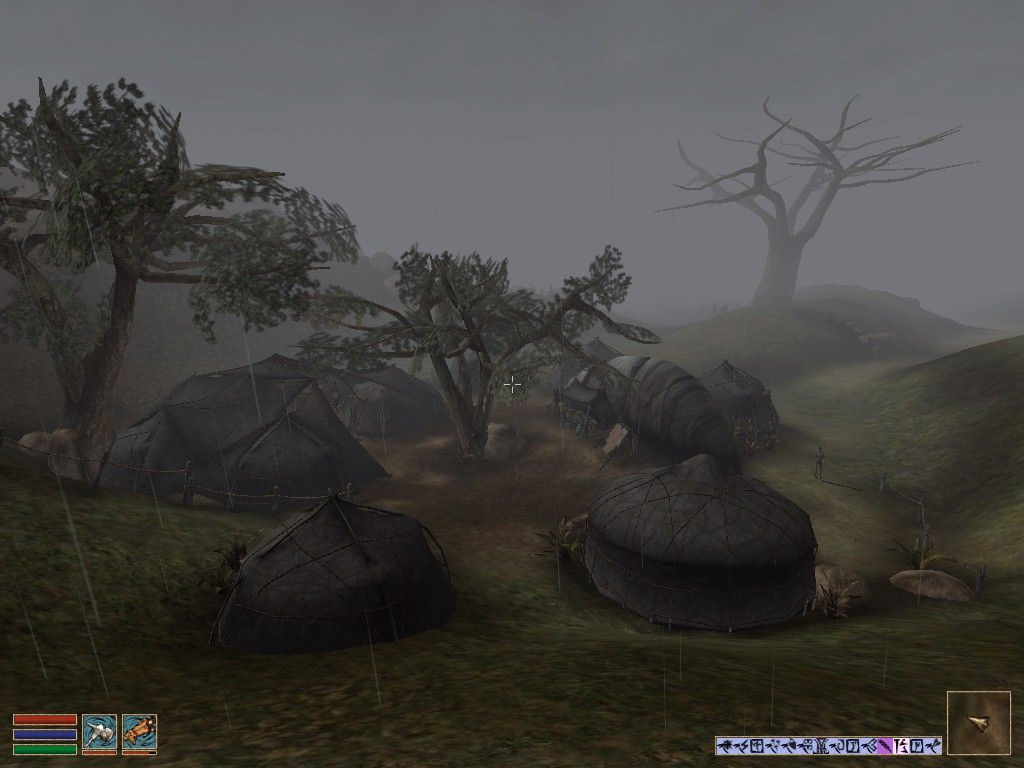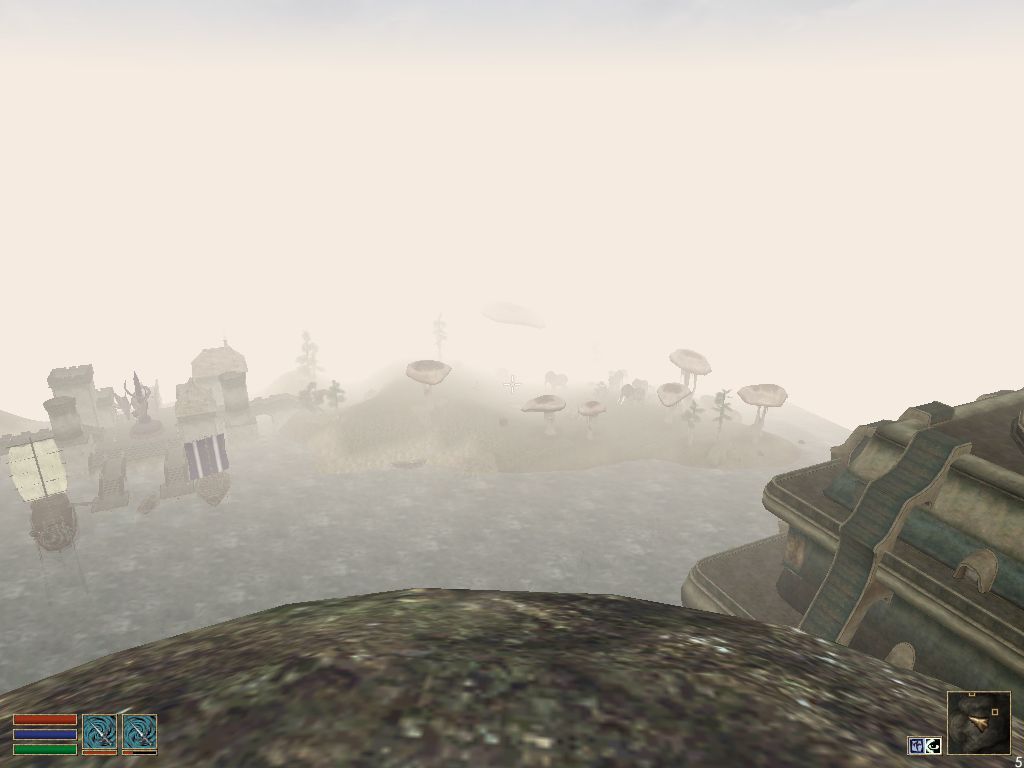Retro Replay Review
Gameplay
The Elder Scrolls III: Morrowind delivers an unparalleled sense of freedom, inviting players to chart their own path through the volcanic island of Vvardenfell. From the moment your character steps off the prison ship, you can choose to follow the main quest, delve into local politics, join one of many guilds, or strike out on a solitary exploration of ruins and wilderness. This sandbox approach means that every playthrough feels unique, with a constant stream of side quests, factions, and hidden secrets waiting to be uncovered.
(HEY YOU!! We hope you enjoy! We try not to run ads. So basically, this is a very expensive hobby running this site. Please consider joining us for updates, forums, and more. Network w/ us to make some cash or friends while retro gaming, and you can win some free retro games for posting. Okay, carry on 👍)
Morrowind’s two-stage skill system encourages organic character development. Primary attributes such as Strength and Intelligence increase when you level up, whereas secondary skills—like Acrobatics, Sneak, and Destruction—improve through repeated use. This design rewards players for focusing on favored play styles, whether that’s casting powerful spells, striking from the shadows, or haggling for better prices in bustling marketplaces.
Combat in Morrowind is straightforward yet strategic. Sword strikes, arrow shots, and spell effects exchange in simple, turn-based–style calculations, but victory often hinges on preparation and tactics. You might don enchanted armor, drink potions to resist heat in the Ashlands, or recruit fellow adventurers to bolster your chances against fearsome daedric creatures. Meanwhile, NPC dispositions—affected by reputation, race, and prior actions—add another layer of depth, as a well-timed bribe or a persuasive argument can open doors that mere steel cannot.
Graphics
For its time, Morrowind’s NDL 3D engine was a technological showcase, rendering sprawling lava fields, mushroom forests, and ash-stained towns with surprising detail. While modern standards may highlight its dated textures and visible pop-in, there’s still a distinct atmosphere to the saffron skies of Vvardenfell, the drifting embers near Red Mountain, and the ancient Dunmer architecture that pervades the landscape.
Interiors transition in with loading screens, a limitation of early 2000s game design, but once inside the ornate temples, guild halls, or player-built homesteads, you’ll find richly modeled altars, tapestry-lined walls, and sun-lit courtyards. Day-night cycles and dynamic lighting further enhance exploration—you witness the glow of ghostly wisps in the depths of Dwemer ruins and the braziers’ flicker in remote Imperial forts.
Thanks to an enthusiastic modding community, Morrowind’s visual presentation has aged gracefully. From high-resolution texture packs to revamped character models, players can tailor the aesthetic to their liking. Even without mods, the game’s art direction and varied environments—from the mushroom-tree canopy of Balmora to the ash dunes around Ald’ruhn—remain evocative and full of character.
Story
You begin Morrowind as a prisoner, freed at the command of Emperor Uriel Septim VII and dispatched to the remote province of Morrowind. Haunted by enigmatic dreams, you are swiftly recruited by the Blades to investigate a dark conspiracy that threatens not only the island but the fate of Tamriel itself. This setup provides both urgency and mystery, driving you to uncover ancient prophecies and confront powers beyond mortal reckoning.
As you delve deeper, alliances with the Great Houses—Hlaalu, Redoran, and Telvanni—and other factions such as the Fighters Guild or the Mages Guild shape the narrative. Each organization offers its own perspective on the looming threat of Dagoth Ur, weaving political intrigue with mythic revelation. Your choices in dialogue and action influence NPC allegiances and can lead to entirely different outcomes within secondary questlines.
The climactic confrontation with the evil deity behind Morrowind’s turmoil feels earned after hours of investigation, artifact hunting, and skirmishes with the Sixth House cult. Though the overarching plot is more linear than your side activities, it remains compelling, blending high-fantasy stakes with the gritty reality of life under ash-fall and foreign occupation. Every recovered scroll and prophesied clue brings you closer to unlocking the secret of the Heart of Lorkhan.
Overall Experience
Morrowind stands as a landmark in open-world RPG design. Its world feels living and reactive: guards challenge suspicious behavior, merchants adjust prices based on your reputation, and even a humble mudcrab can surprise an overconfident adventurer. The sense of accomplishment when you decipher a cryptic note, navigate a treacherous ruin, or broker peace between rival houses remains as satisfying today as it was at launch.
While modern players may find elements like paper-doll inventory management or clunky jumping mechanics archaic, these quirks contribute to its enduring charm. The absence of quest markers and minimaps encourages genuine exploration, promoting a deeper connection to Morrowind’s richly detailed world. It’s a game that demands patience and curiosity but rewards both with unforgettable discoveries.
Ultimately, The Elder Scrolls III: Morrowind is more than the sum of its technical parts. It’s an invitation to become a legend in a land full of wonders, dangers, and political machinations. Whether you’re enlisting in the Blades, mastering obscure spells, or simply wandering the ash-soaked hills, Morrowind offers a truly personalized adventure that continues to captivate RPG enthusiasts two decades after its release.
 Retro Replay Retro Replay gaming reviews, news, emulation, geek stuff and more!
Retro Replay Retro Replay gaming reviews, news, emulation, geek stuff and more!









Reviews
There are no reviews yet.